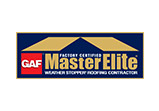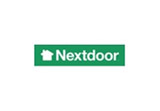As a homeowner, residential roof repairs are often a top concern due to the potential for unexpected costs, making it a priority to address any issues promptly to avoid further damage and expenses. In the end, your roof is one of the most important components of your house. It protects you, your family, and your belongings from the elements, so it’s crucial to keep it in good repair. However, over time, even the most well-built roof can experience damage and wear and tear. From small leaks to missing shingles, there are many issues that can arise with your residential roof.
In this page, we’ll explore everything we the experts believe you should know about roof repairs in a residential context. For other types of services such as Commercial Roof Repairs, we have a separate article that covers this topic in great depth. Here, we’ll cover common types of roof damage, signs that your roof may need repair, and steps you can take to prevent future issues. Whether you’re a new homeowner or have lived in your house for years, this guide will provide you with the information you need to keep your roof in top condition and protect your home and family.
After reading this article, you will have expert answers to the following questions:
- What are some signs that my roof needs repair?
- How often should I have my roof inspected and repaired?
- How long does a typical roof repair take?
- Can I repair my roof myself, or should I hire a professional?
- How much does it cost to repair a roof?
- What are some common causes of roof damage?
- What are some preventative measures I can take to avoid roof damage?
- Will my homeowner’s insurance cover the cost of roof repair?
- Can I repair just a section of my roof, or does the entire roof need to be replaced?
- How do I know if my roof needs to be replaced instead of repaired?
Before we dive deeper into the topic of residential roofing and repairs, it’s important to first understand what types of roofs are commonly used in South Florida. Different types of roofs have unique properties and require different maintenance and repair methods. By learning about the types of roofs, homeowners can better understand what to expect from their roofing system and how to properly care for it.
What are the different types of roofs commonly in need of repair for residential properties?
As a homeowner, one of the biggest decisions you’ll make is choosing the type of roof for your home. Your roof not only protects your home and your family from the elements, but it also adds to your home’s curb appeal and value. With so many different types of residential roofs available in North America, it can be overwhelming to decide which one is right for you.
Fortunately, the decision regarding the type of roof for a dwelling is typically left in the hands of architects and developers. These professionals possess extensive knowledge of different types of roofs and construction methods that are appropriate for the type of dwelling they are designing. As a homeowner, the decision of the roof type will already be made for you when you purchase a new house. Structural choices will have already been applied to the design, and your focus will be on the look, feel, and general architectural appeal of the home.
However, it’s still important to understand the type of roof that comes with your new house to properly maintain and care for it in the future. Different types of roofs have different maintenance needs and lifespans, and knowing what to expect can save you time, money, and headaches down the road. By understanding the care and maintenance requirements of your roof, you can take steps to ensure it stays in top condition for years to come.
Here are some common roof classes/types for homes in South Florida.
- Asphalt Shingle Roof: This is one of the most popular types of residential roofing in North America. Asphalt shingles are affordable, durable, and easy to install, making them a popular choice for homeowners.
- Metal Roof: Metal roofs are becoming increasingly popular due to their durability, energy efficiency, and low maintenance requirements. They come in a variety of materials, including aluminum, steel, and copper.
- Tile Roof: Tile roofs are popular in warmer climates due to their ability to withstand high temperatures and strong sunlight. They are also fire-resistant and can last for several decades if properly maintained.
- Slate Roof: Slate roofs are known for their durability and longevity. They are made from natural slate stone, which gives them a unique and attractive appearance. However, they can be expensive and require specialized installation techniques.
- Wood Shake Roof: Wood shake roofs are a traditional roofing material that adds natural beauty to a home. They are made from wood shingles or shakes, which are split or sawn from logs. However, they can be susceptible to rot and require regular maintenance.
- Flat Roof: Flat roofs are typically used in modern and contemporary home designs. They are flat or nearly flat, with a slight slope to allow for drainage. Flat roofs can be made from a variety of materials, including asphalt, rubber, and PVC.
What are some signs that my roof needs repair?
Damaged, curled, cracked titles or shingles are signs your roof needs repair. Also look after discoloration, leaks or mold.
We already establish that your roof is one of the most important components of your home’s structure, however, many homeowners may not know what signs to look for when their roof needs repair. Here are some common signs that your roof may need attention from a professional:
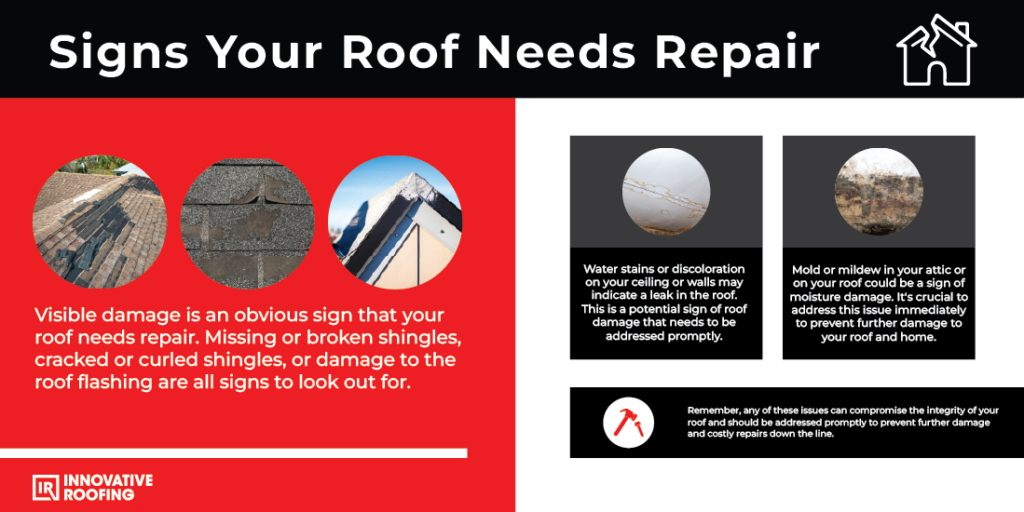
One of the most obvious signs that your roof needs repair is visible damage. This may include missing or broken shingles, cracked or curled shingles, or damage to the roof flashing. Another sign of potential roof damage is water stains or discoloration on your ceiling or walls, which may indicate a leak in the roof. Additionally, if you notice any signs of mold or mildew in your attic or on your roof, this could be a sign of moisture damage and should be addressed immediately. Any of these issues can compromise the integrity of your roof and should be addressed promptly to prevent further damage and costly repairs down the line.
How often should I have my roof inspected and repaired?
Industry experts recommend having your roof inspected at least once a year. It’s best to schedule an inspection before the start of winter and after the end of spring, as these are the seasons when your roof is most likely to experience damage.
Regular inspections and maintenance of your roof can help extend its lifespan and prevent costly repairs down the line. But how often should you have your roof inspected and repaired?
Industry experts recommend having your roof inspected at least once a year. It’s best to schedule an inspection before the start of winter and after the end of spring, as these are the seasons when your roof is most likely to experience damage. Additionally, if you live in an area with frequent severe weather events such as hailstorms or high winds, it’s recommended to have your roof inspected more frequently, as these events can cause significant damage to your roof.
In terms of repairs, it’s important to address any issues as soon as they arise to prevent further damage to your roof and home. Small repairs can often be made quickly and at a relatively low cost, but if left unaddressed, they can turn into larger and more expensive repairs. If you notice any signs of damage or have concerns about the condition of your roof, it’s best to have a professional inspection to determine the extent of any necessary repairs. Overall, regular inspections and prompt repairs can help ensure the longevity and functionality of your roof for years to come.
How long does a typical roof repair take?
The duration of a typical roof repair can vary depending on the extent of the damage and the size of your roof. Minor repairs, such as fixing a few missing shingles, can usually be completed within a few hours. However, more extensive repairs or complete roof replacements can take several days to complete. Factors that can impact the duration of a roof repair include the type of roofing material, the size and pitch of the roof, and weather conditions.
It’s important to note that rushing a roof repair can result in subpar workmanship and potential future issues. Taking the time to do a thorough repair or replacement job will ensure the longevity and safety of your roof. When working with a professional roofing contractor, they should be able to provide you with a timeline for the repair or replacement and keep you updated throughout the process.
Can I repair my roof myself, or should I hire a professional?
Repairing a roof is a significant undertaking that requires experience, skill, and the right tools. While some homeowners may be tempted to try and tackle roof repairs themselves to save money, it’s important to understand the risks involved. Without the proper training and equipment, attempting to repair a roof can be dangerous, especially for those who are not accustomed to working at heights. Additionally, DIY repairs can result in costly mistakes that may further damage the roof or even compromise its structural integrity.
It’s generally recommended that homeowners hire a professional roofing contractor to handle any roof repairs. A professional roofing contractor has the expertise and experience necessary to properly diagnose and repair roof issues. They are trained to identify and address the root cause of the problem, rather than just patching up the visible damage. Moreover, professional roofers are equipped to handle any unexpected issues that may arise during the repair process, ensuring that the job is completed efficiently and effectively.
Although hiring a professional roofer may appear to be a simple task, it is crucial to be prepared and have some important considerations in mind before choosing a contractor and signing a contract. To start with, it is recommended to research and identify at least three potential roofing companies in your area to obtain quotes and compare prices. It is also important to check their credentials, including licenses, insurance, and certifications, to ensure that they are qualified and authorized to perform the work.
Affiliations
Find a roofer in your area with affiliations. Utilizing extensive knowledge in industry advancements and best practices can provide you with turn-key solutions engineered even under the most demanding conditions.
Certifications
Make sure you are dealing with a State Licensed and Certified Roofing Contractor who can provide products and services that can meet/surpass industry standards.
Additionally, it is crucial to have a clear understanding of the scope of work and all the associated costs, including labor, materials, and any potential additional fees or charges. This information should be detailed in a written contract that outlines the terms and conditions of the work to be performed. By being prepared and taking the time to choose a qualified and reputable professional, you can help ensure that your roofing project is completed safely, efficiently, and to your satisfaction.
How much does it cost to repair a roof?
The cost of repairing a small section of a roof typically falls between the range of $200 to $500. For metal roofs, the cost may increase to $500 to $1,500 per section. A complete roof replacement can be significantly more and may cost between $5,000 to $10,000
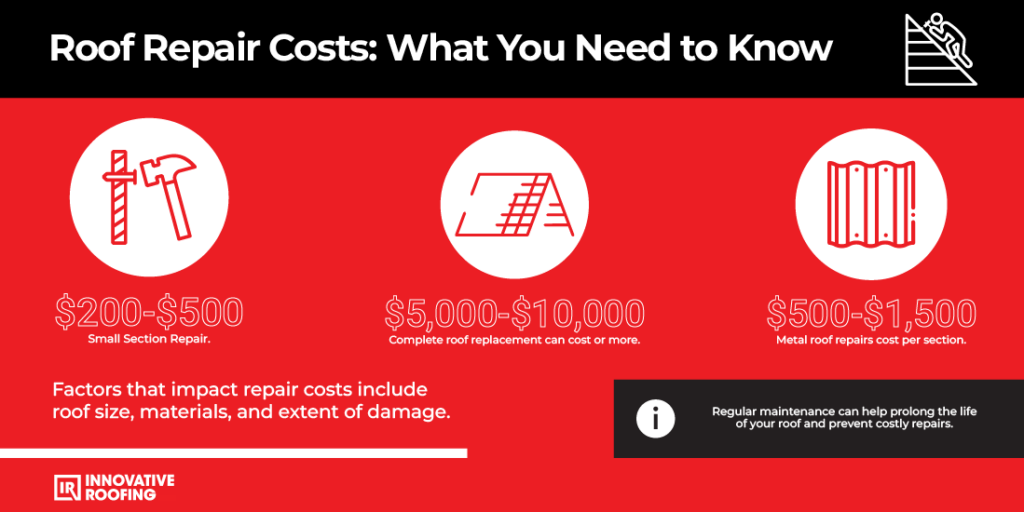
The cost of repairing a roof can vary greatly depending on the type of roof, the extent of the damage, and the region where the repair is being done. In general, the cost of a roof repair can range from a few hundred to several thousand dollars. For example, repairing a small section of asphalt shingle roof may cost around $200-$500, while repairing a metal roof may cost around $500-$1,500 for a small section. On the other hand, if the damage is extensive and requires a full roof replacement, the cost can range from $5,000-$10,000 or more.
It is important to note that while cost is a significant factor in roof repair, it should not be the only consideration. Hiring an experienced and certified roofer is critical to ensuring that the repair is done properly and will last for many years to come. A poor repair job can result in further damage and costly repairs down the line, so it is important to choose a reputable roofer who is knowledgeable and experienced in the type of roof being repaired. Additionally, some roofing companies offer financing options or work with insurance companies to help offset the cost of repairs, making it more manageable for homeowners.
What are some common causes of roof damage?
Roofs are designed to withstand various weather conditions, but they are not immune to damage. One of the most common causes of roof damage is extreme weather conditions. Heavy rain, snow, hail, and wind can cause damage to shingles, tiles, and flashing. In extreme cases, the roof may even collapse. It is important to have your roof inspected after severe weather to identify any potential damage that may need to be repaired.
Another common cause of roof damage is poor maintenance. Failing to keep your roof clean and well-maintained can lead to the growth of mold, mildew, and algae. This can cause your roof to deteriorate over time and can even lead to leaks. Regular maintenance such as cleaning gutters and trimming overhanging branches can help prevent damage to your roof. Additionally, regular inspections by a certified roofing professional can help identify any potential issues before they turn into major problems.
Roof Damage for Florida Homeowners
Florida is known for its hot and humid weather, as well as its frequent thunderstorms, hurricanes, and tropical storms. These weather conditions can have a significant impact on the lifespan and condition of residential roofs. The intense heat and humidity can cause asphalt shingles to deteriorate and lose their protective granules, making them more vulnerable to damage from other weather events. In addition, UV rays can cause the materials in the roof to break down and weaken over time, leading to leaks and other forms of damage.
Thunderstorms and tropical storms can also cause damage to roofs in Florida. Heavy rains can lead to pooling water, which can seep through small cracks or gaps in the roof and cause leaks. Wind can also cause damage to roofs, especially if the shingles are loose or damaged. Hurricane-force winds can be particularly devastating, and can cause roofs to be ripped off entirely or collapse under the pressure. For homeowners in Florida, it is important to take into account the weather conditions in the area and ensure that their roofs are designed and built to withstand the elements.
What are some preventative measures I can take to avoid roof damage?
Preventative measures can go a long way in keeping your roof in good condition and avoiding costly repairs. Regular roof maintenance is key, which includes cleaning the gutters and inspecting the roof for any signs of damage or wear and tear. Keeping your gutters free of debris such as leaves, branches, and dirt will ensure that rainwater flows freely and doesn’t accumulate on your roof, which can cause damage over time. Additionally, regular inspections can catch any minor issues before they become major problems.
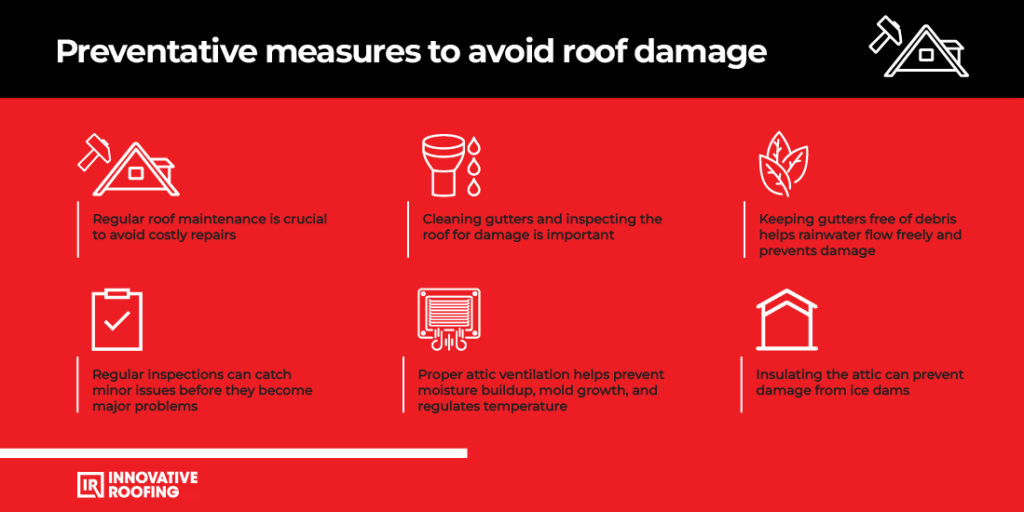
Another preventative measure to consider is investing in proper attic ventilation. A well-ventilated attic can help prevent moisture buildup, which can lead to mold growth and roof damage. It can also help regulate the temperature in your home, which can reduce energy costs. Insulating your attic can also help regulate temperature and prevent damage from ice dams, which can form when snow and ice melt and refreeze on the roof. By taking these preventative measures, you can help ensure that your roof lasts longer and stays in good condition.
Will my homeowner’s insurance cover the cost of roof repair?
The coverage of homeowner’s insurance for roof repair costs depends on various factors, such as the cause of damage, age of the roof, and the type of policy. Generally, sudden and accidental damage caused by events such as storms, hail, fallen trees, or vandalism are covered by most homeowner’s insurance policies. However, damage caused by regular wear and tear, neglect, or lack of maintenance is usually not covered. It is important to carefully review your policy and speak with your insurance agent to understand the specific terms and limitations of your coverage. Additionally, if you live in an area prone to weather-related damage, such as hurricanes or tornadoes, you may need to purchase additional coverage or a separate policy to ensure full protection for your roof.
When filing a claim for roof repair, it is important to document the damage thoroughly with photographs and detailed descriptions. Your insurance company may also require an inspection by a professional roofer to assess the extent of the damage and provide an estimate for repairs. Keep in mind that there may be a deductible that you will need to pay out of pocket before your insurance coverage kicks in. It is also important to choose a reputable and experienced roofing contractor to ensure that the repairs are done properly and meet the standards required by your insurance company.
Can I repair just a section of my roof, or does the entire roof need to be replaced?
Whether you need to repair just a section of your roof or replace the entire roof depends on the severity and extent of the damage. If the damage is limited to a small area, such as a few missing or damaged shingles, then repairing just that section may be sufficient. However, if the damage is widespread, such as in cases of significant water damage or deterioration, then a full roof replacement may be necessary. Additionally, if your roof is approaching the end of its lifespan, it may be more cost-effective to replace the entire roof rather than continually making repairs.
To determine whether a partial or full roof replacement is necessary, it’s important to have a professional roofer inspect your roof. They can assess the extent of the damage and provide recommendations for repair or replacement. It’s also important to keep in mind that if you choose to repair just a section of your roof, it may not match the rest of the roof in terms of age and appearance, which could impact the overall aesthetic of your home.
Homeowners part of an HOA
HOA (Homeowners Association) rules regarding roof replacement can vary depending on the specific association and the location of the property. In some cases, the HOA may have strict regulations regarding the type of roofing materials that can be used and the color and style of the roof. Some associations may require a certain type of roof, such as tile or metal, to maintain a cohesive look throughout the community.
Before beginning any roof replacement project, it is important to consult with the HOA to determine what regulations are in place. Failure to comply with HOA rules and regulations can result in fines or even legal action. Additionally, it is important to ensure that any roofing contractor hired to perform the work is licensed and insured, as some associations may require this as well. By following the guidelines set forth by the HOA, homeowners can ensure a successful roof replacement project that meets the expectations of the association and enhances the overall value of the property.
How do I know if my roof needs to be replaced instead of repaired?
Typically, roofs have a lifespan of 15 to 25 years, although the duration may vary depending on various factors. If your roof is more than 25 years old, it may require a complete replacement evaluation to ensure it is still functional and safe.
There are a few circumstances under which a roof will need to be replaced rather than repaired. One of the most common is age. Roofs have a lifespan, and once a roof reaches the end of its useful life, it will need to be replaced. The age at which a roof needs to be replaced depends on a number of factors, including the type of roof and the climate in which it is installed. As a general rule, most roofs will last between 15 and 25 years, but some may last longer or shorter depending on their specific characteristics.
Another reason a roof may need to be replaced is if it has suffered significant damage. If a roof has sustained damage from a severe storm or other natural disaster, it may not be possible to repair it. In some cases, the damage may be so extensive that it compromises the structural integrity of the roof, making repair impossible. Additionally, if the damage is widespread across the roof, it may be more cost-effective to replace the entire roof rather than trying to repair multiple sections. A professional roofing contractor can help you determine the extent of the damage and whether repair or replacement is the best course of action.
Residential Roof Repair or Replacement Assessment
Here’s a checklist of questions to help determine if a roof needs to be replaced:
- How old is the roof? Most roofs have a lifespan of 20-30 years, so if the roof is approaching or has exceeded that lifespan, it may be time to consider replacement.
- Are there missing or broken shingles? If there are a significant number of missing or broken shingles, this could indicate that the roof is beyond repair.
- Is there extensive damage or leaks? If the damage is widespread or there are significant leaks that cannot be repaired, a full roof replacement may be necessary.
- Has the roof been repaired before? If the roof has been repaired multiple times, it may be more cost-effective in the long run to replace it instead of continuing to repair it.
- Are there signs of rot or decay? If the roof decking or supporting structures are rotting or decaying, a replacement may be necessary to prevent further damage and ensure safety.
- Has the roof been damaged by severe weather events? If the roof has sustained significant damage from a severe storm or natural disaster, a replacement may be necessary to ensure the safety and integrity of the roof.
- Is the roof’s appearance significantly deteriorated? If the roof’s appearance is significantly deteriorated or affecting the curb appeal of the home, a replacement may be necessary to improve the overall look of the property.
By answering these questions, homeowners can make an informed decision about whether a roof replacement is necessary. It is important to consult with a professional roofing contractor to assess the condition of the roof and provide recommendations for repair or replacement.










